


The movies come to
Nambour
For the purpose of this story, and to remain faithful to the usage of the first half of the 20th century, we will refrain from using the modern American term 'movies' except when the sense demands it. Instead, we will use the term 'pictures', meaning 'moving pictures'. In Australia at the time, people would talk about 'going to the pictures', although 'going to the flicks' was also a popular term, harking back to the silent film era, when the projection rate of 18 frames per second made the images flicker and movement appear somewhat jerky. The words 'cinema' and 'theatre' were used interchangeably, although by rights a 'cinema' was where moving pictures or 'films' were projected on a screen, whereas a 'theatre' was a place of live entertainment on a stage, such as plays, operas, concerts or pantomimes. The hybrid term 'picture theatre' was in common use, this nomenclature being given legitimacy by its use in Government legislation, such as 'The Picture Theatres and Films Acts of 1946'. When the first sound films appeared in Australia in 1928, they were referred to as 'Talkies' for at least twenty years after that. {7-5-1948, p.4} {30-4-1948, p.10}
*******************************************************
In the 1890s, itinerant showmen
travelled around the country with their limelight magic lantern shows. With
the dawning of the twentieth century, they brought their newly-invented
portable moving picture machines known variously as Biographs, Bioscopes, Kinetoscopes
or 'Kinematograph Entertainments'. Many
followed the annual agricultural shows which were beginning to appear in rural
areas. As there was usually no electricity available, they had to bring their
own generating apparatus with them, consisting of a steam or oil engine driving a dynamo.
Some of these 'picture show men' set up their equipment and screens in the open air, some brought their own large tents, and others hired the public halls that were being erected by local committees all over the nation. As early as 3rd April 1905, when moving pictures were in their infancy, Mr J. Clark brought his new machine "specially imported from America" to Nambour, showing "beautiful films full of real life and energy." {31-3-1905, p.4}
To support these short, one reel silent pictures he provided variety entertainment, including "illustrated songs, wire-walking, comic songs and specialties, headed by Andree, the world's greatest conjurer and juggler." The venue was Winterford's Hall, and tickets cost a shilling for adults, sixpence for children. Reserved seats cost two shillings. Those prices were roughly equivalent to what we pay for cinema tickets today. {31-3-1905, p.4}



Images courtesy Sunshine Coast Libraries
Winterford's Hall had been built by Mr William Henry Winterford, licensee of the Royal Hotel, at the same time the Hotel was built, 1903. It was one of the earliest buildings built for public use in Nambour, but was not very large. It was sited just downhill from today's McDonalds fast-food outlet. Mr Winterford was a keen sportsman, and a crack shot in the Nambour Rifle Club He was also one of the first men to develop the Nambour Heights area for housing {24-11-1905, p.2}. The Hall was built to provide a meeting place for local clubs (including the Nambour Lawn Tennis Club, Nambour Cricket Club and Nambour Football Club) and as a venue for social gatherings, concerts, plays and Roman Catholic and Church of England activities {05-08-1904, p.2}. It had a good dance floor and was also used for events such as Plain and Fancy Dress Balls {29-04-1904, p.4}. The Friday before Mr Clark came to town, it was the venue for a Grand Concert with 21 items on the program. The Chronicle of 26th October 1906 ran this advertisement: "A Grand Biograph Exhibition of Living Pictures will be held in Winterford's Hall on Saturday, Nov. 3, 1906 at 8 pm, in aid of Prize Fund of Nambour State School. Realistic, thrilling, beautiful and humorous subjects. Also several popular and beautifully illustrated songs to be sung by Miss Bennett and Messrs. Frame and Brookes. Admission: Adults 1s., Children 6d." {19-08-1904, p.3} {12-10-1906, p.2} {26-10-1906, p.4}
The same issue of the paper
carried a lengthy article about the recent visit of the
Rt Hon Frederic John Napier Thesiger, Baron Chelmsford, GCMG, GCSI, GCIE, GBE.
He was the Governor of Queensland at the time, and was known generally as Lord
Chelmsford. [His father is known in history as General Frederic Augustus
Thesiger, the second Baron Chelmsford, whose technologically superior
British army was soundly defeated by King Cetshwayo's Zulu forces at the
Battle of Isandhlwana in January 1879 (the nearby Battle of Rorke's
Drift followed the next day), leading to Thesiger's being relieved of command for incompetence.]
His Excellency
and Lady Chelmsford had come to see the district, and to open the Kenilworth
to Mapleton Road. At 6 pm on the evening he spent in Nambour, a
banquet for 60 people was held for him at the Winterford's Hall. It is likely
that the hotel kitchen provided the "liberal bill of fare". After
speeches, the vice-regal party walked the short distance to the Nambour
Station and boarded their special train. The newspaper report continued, "On
leaving [they] were cheered by the large number of persons assembled on the
Railway Station. A number of fog signals [detonators] placed on the rails were
exploded by the train as it drew out, and gave the crowd a start which
materially helped them off the platform. During the evening a number of people
indulged in a dance in the hall at Mrs Winterford's invitation. Mr A. Bennett
acted as M.C. and volunteers supplied the music."
{26-10-1906,
p.4}
By early 1907 Mr Winterford had decided to move on and acquire the lease of a large hotel, the Shamrock, in Edward Street, Brisbane. The lease of the Royal Hotel was auctioned on Saturday, 27th April and the winning lessee was Mr Arthur Edwin Godwin. He immediately set about making improvements, firstly to the Hotel itself, and then to the Hall, which up to that time had been unceiled and was often reported in the press as having a gloomy and "usually uninviting interior" {29-04-1904, p.4}, unless the hirers brought their own better kerosene lighting. The Nambour Chronicle of 4th May, 1907 reported these events on page 4:
"The auction sale at the [Royal] hotel last
Saturday turned out most successfully, and Mr Winterford is very pleased
that he took that course instead of accepting the usual 'sporting offer'
made in such cases by the incoming lessee. In fact he has asked us to
mention that the auctioneers deserve great credit for the way they conducted
the sale, and the hard work they put in. As a result he says he has a
hundred or two more than he expected wherewith to set himself up in the
Shamrock Hotel, his next house, which for the information of those who are
likely to visit Brisbane and want a good place to put up at, we may say is
in Edward Street, next to Smellie & Co's warehouse, opposite the Shipping
Office, and near the Edward St. Ferry, and the entrance to the Botanical
Gardens. It is therefore a quiet spot yet convenient.
"Things are gradually getting into shape at the Royal under Mr Godwin, the new lessee, but it will be some time before everything is in proper order. The alterations have been started, but attention is being given to the accommodation of lodgers in the first place. The bedrooms were first furnished, and then the dining room and bar. The Hall is at present in charge of the carpenters and special provision is being made to provide means of distributing sound among the audience instead of the rafters of the roof. The first entertainment is advertised on Monday night, and we are informed that ample seating facilities including 70 A.B. [Austrian Bentwood?] chairs will also be provided. We hope soon to be able to give further particulars of the many improvements in hand on the premises."
On the day of the sale, St John's Church of England placed an advertisement in the Nambour Chronicle promoting their annual Sunday School Picnic on the following Empire Day, May 24th, which would be followed by a concert and prize-giving in the evening, at a venue named as the "Royal Hotel Hall" {27-04-1904, p.2}. Apparently, the person who placed the advertisement realised that the name "Winterford's Hall" would be inappropriate under the new ownership. Within two weeks after the sale, Arthur Godwin had completed most of his improvements and was advertising an entertainment by the "World famed LONDON PIEROTS" in his Hall which he called the "Royal Hotel Hall" {11-05-1907, p 4}. This name was temporary, probably to avoid confusion for readers, as newspaper reports and advertisements in the Nambour Chronicle show that the name had been shortened to "Royal Hall" from the beginning of June, 1907 {01-06-1907, p 2}. Mr Godwin continued to provide live entertainment and moving pictures for the public, as the advertisement at left indicates {10-08-1907, p 2}. In less than three months however, Mr Godwin had thought of a more interesting name for his Hall, and an advertisement in the Nambour Chronicle of that date advised readers that a Euchre Party organised by the Nambour Lawn Tennis Club would be held in the "Alhambra Hall" {24-08-1907, p.2}. This name, taken from the magnificent Moorish palace and fortress in Granada, Andalusia, was a little exaggerated for a tiny, square, wooden building, but nonetheless it retained that name for the next half century. Press clippings reporting these events may be read here .
On 11th December 1907, Messrs. J. and N. Tait came to Nambour and hired the Alhambra Hall. There they screened their new production, The Story of the Kelly Gang, an hour-long film on six reels recounting the life of the bushranger Ned Kelly, culminating in the famous siege at Glenrowan. This Australian film had been made the previous year, and was probably the first full-length feature film ever produced in the world. It was advertised in The Chronicle of 7th December, the show being accompanied by film of the previous month's Melbourne Cup and illustrated songs by the eminent baritone Mr R. J. Needham. Some stills from the film, a poster and sixteen film clips are available here.
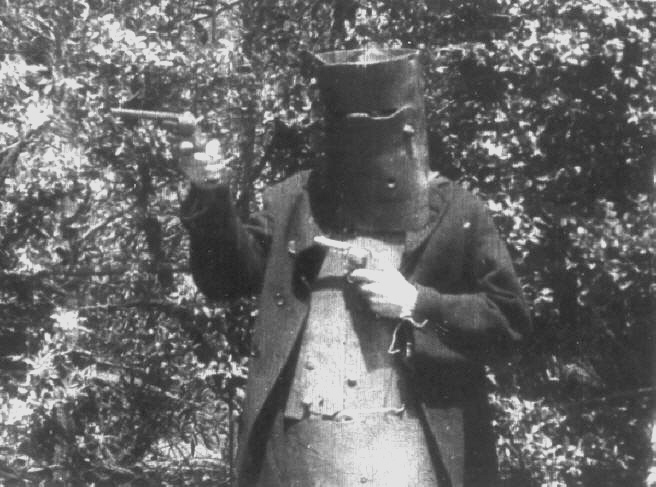
A still from The Story of the Kelly Gang. Image courtesy National Film and Sound Archive
In September 1913 the new Nambour Town Hall was opened with a large auditorium attached, and this attracted much of the patronage previously enjoyed by the Alhambra Hall, but it was still used for smaller-scale meetings and social gatherings. The Alhambra Hall remained in use next to the Royal Hotel for half a century until 1953, when it was moved a few hundred metres north across Petrie Creek to a new site in Coronation Avenue, just over the bridge, where the R.S.L. car park exists now. At that time it was raised three or four metres above street level, and an additional ground floor added beneath the Hall, where shops were fitted out. Upstairs, the hall was used for dances. The following advertisement in the Nambour Chronicle announced its re-opening:
"Calling all Dancers, tonight, Friday, 11/9/53. Opening of the New Alhambra Hall, Nambour. Novelty Dances. Lucky Door Ticket. Gala Night. Admission 3/-." {16-1-1953, p.7} {2-4-1953, p.8} {11-9-1953, p.7} {18-9-1953, p.9} {25-9-1953, p.13}
Dances seem to have ended at the New Alhambra Hall after six months, and the top floor became a meeting place for the Seventh Day Adventist Church and a venue for public auctions. {26-3-1954, p.9} {26-3-1954, p.14} {2-4-1954, p.6} {9-4-1954, p.16} {29-10-1954, p.8}

The Royal Hotel, with the Alhambra Hall on its northern
(right-hand) side.
Photograph courtesy Sunshine Coast Libraries

The same site in 2008.

When the Alhambra Hall was removed in the Queen's
coronation year of 1953, this new building was erected on the site, and
named 'Coronation House'. The Royal Hotel is glimpsed at the left margin.
Photograph dated 1953.
Photograph courtesy Sunshine Coast Libraries
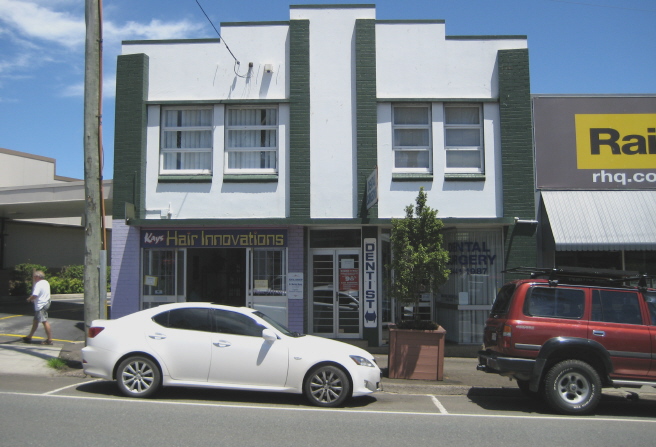
Coronation House in November 2008, used as a hairdressing salon and dental surgery.

The environs of the erstwhile Coronation House building in November 2008.

The view across the bridge over Petrie Creek, looking up
Currie Street, in 1916. At the top of the street at right is the large Royal Hotel,
with the small, square Alhambra Hall in front of it.
Photograph courtesy Sunshine Coast Libraries

The same view in 2008.

The R.S.L. car park in 2008. This was where the Alhambra Hall was relocated in 1953. At the time, the road north of the Petrie Creek bridge (right of picture) was named 'Coronation Drive' - now 'Coronation Avenue'.
Returning to the first decade of the 20th century, on 18th October 1907 the Alhambra Hall was hired by the local School of Arts group for their "concert and social, to raise the nucleus of a fund for the purpose of establishing their own School of Arts." A Mr Bennett, possibly the same Mr A. Bennett referred to earlier, presented some films at the Alhambra Hall in February 1913. By February 1914 he was regularly screening films in both Nambour and Yandina. He often augmented his program with live entertainment, such as illustrated songs. {24-9-1948, p.6} {11-5-1951, Supplement p.4} {2-4-1953, p.8} {25-9-1953, p.13} {5-10-1907, p.2} {14-2-1913, p.2} {6-2-1914, p.7}


Images courtesy Sunshine Coast Libraries
 Express
Electric Pictures operated at the new Nambour Town Hall for ten weeks, from
24th February 1915 to 5th May 1915. Moving pictures had by then developed in
style, technique and quality to a form that we would enjoy today. They were
still silent and on black and white film, although sometimes colour tinting
was applied to parts of a film by hand. Projected at 18 frames per second,
they would appear a little jerky to modern audiences, used to the smoother
motion of 24 frames per second that was introduced with the advent of the
'talkies'. Musical accompaniment was provided by a pianist or small
orchestral ensemble for some features.
The first cartoons and newsreels were appearing, bringing additional enjoyment
and information about the world to our local people.
{17-11-1916, p.2} {5-1-1917, p.2}
Express
Electric Pictures operated at the new Nambour Town Hall for ten weeks, from
24th February 1915 to 5th May 1915. Moving pictures had by then developed in
style, technique and quality to a form that we would enjoy today. They were
still silent and on black and white film, although sometimes colour tinting
was applied to parts of a film by hand. Projected at 18 frames per second,
they would appear a little jerky to modern audiences, used to the smoother
motion of 24 frames per second that was introduced with the advent of the
'talkies'. Musical accompaniment was provided by a pianist or small
orchestral ensemble for some features.
The first cartoons and newsreels were appearing, bringing additional enjoyment
and information about the world to our local people.
{17-11-1916, p.2} {5-1-1917, p.2}
Meanwhile, Mr Bennett widened the audience for his travelling cinema to include other villages in the district, and in April 1915 his weekly run brought moving pictures to Landsborough, Mooloolah, and Woombye as well as Nambour. On 7th April of that year his program was entitled "The Great European War - 2000 feet of historical importance depicting the fighting in Belgium." By November 1916 he was hiring the Nambour Town Hall every Saturday night for his programs, which his advertisements in The Chronicle said included "dramas, comedy and scenic subjects." {19-2-1915, p.7} {30-4-1915, p.2} {9-4-1915, p.2} {26-1-1917, p.2} {2-2-1917, p.2}
Here is an example of his busy weekly itinerary: Mr Bennett screened a program at the Nambour Town Hall on Saturday, 27th January 1917. The following Tuesday night he was at Buderim, the next night at Beerwah, and the Thursday night at Woombye. On Saturday, 3rd February he was back at the Nambour Town Hall with a new program including the feature film, ‘A Political Scandal’. {26-1-1917, p.2} {2-2-1917, p.2}
Eventually he decided to lease the Town Hall as his permanent base. His programs were popular, and "Bennett's Pictures" soon became familiarly known around the town as "B.P". The newsreels being shown included 'Pathe's English Gazette', the 'Australian Gazette' and the 'World's News Gazette'. To encourage patrons to make their Saturday night attendance a regular thing, he included in each program a comedy short and an episode of the new cliff-hanger serials, a favourite being 'Thunderbolt Jack'. {8-9-1922, p.5} {17-11-1916, p.2} {3-10-1919, p.4} {20-10-1922, p.4} {19-1-1923, p.4}

Nambour Town Hall in 1925.
Photograph courtesy Sunshine Coast Libraries

The same site in 2008.
With the end of the Great War and the new spirit of optimism that characterised the jazz age of the early 1920s, there was a resumption of movie-making, particularly comedies, action films and romances. Other people in Nambour began to consider entering the cinema business. In order to protect existing operators, and to ensure that all cinemas complied with health and safety regulations (particularly with regard to fire-safety), the Government set up the Picture Theatres and Films Commission, which was empowered to license cinema owners on a yearly basis. An applicant for a licence in our district had first to gain the approval of the Maroochy Shire Council and then of the Commission.
Soldiers returning from the battlefields of Europe usually formed a local Sub-branch of the Returned Sailors' and Soldiers' Imperial League of Australia (known then as the R.S.S.I.L.A., now the R.S.L. or Returned & Services League of Australia) in their home towns. They wished to preserve and foster the spirit of mateship that had allowed them to endure the war years. To support them, local citizens erected Soldiers' Halls or Diggers' Halls or Memorial Halls all over the country.
A Sub-branch was formed in Nambour on 24th August 1918, three months before the Great War had ended. The returned Diggers met in the Alhambra Hall in Currie Street, next door to the Royal Hotel. There were about 26 of them, but only about 15 were active members. They soon wanted to have their own Hall and meeting rooms in Howard Street (still called Petrie Creek Road by some writers of the time). They chose a site close to the centre of town, where Keyline Real Estate is located today. Queen Street did not exist then, but the Royal George and Club Hotels were both a mere stone's throw away. The citizens of Nambour who wished to commemorate both the returned servicemen and their fallen comrades set up a Ways and Means Committee to help the Diggers get their hall. {15-6-1923, p.2} {15-6-1923, p.2}
To begin their fund-raising they held a Plain and Fancy Dress Ball in the Town Hall on the 26th September 1919. The next day, the Nambour Turf Club held a benefit race meeting to help their funds along. The Moreton Mill and Maroochy Shire Council also assisted the Diggers to raise money by running tramway excursions for them. {12-9-1919, p.5}
By November 1921, the objective was within reach and building had begun. However, a shortage of corrugated iron held up the project for some weeks. A 'mile of pennies' project was started, and by Armistice Day the line was 140 yards long, representing a value of ₤20 /17 / 6d. The Ways and Means Committee hoped by Christmas to have completed the mile, which would represent a total of ₤220. They soon reached their target and the new Soldiers' Memorial Hall was erected and in use early in 1922. It was placed on the site of Thomas Howard's original house, which was moved 100 yards east to a position near today's Ann Street. The Committee managed the Hall for the R.S.S.I.L.A., and the Diggers could use it as they wished. {2-12-1921, p.5} {11-11-1921, p.5}

This building which is on the corner of Howard Street and Queen Street in 2008, occupies the site of the original Soldiers' Hall opened in 1922. Within a short time it became known as Nambour's Diggers' Hall.
 The building, though useable, was
not lined or ceiled. It had no floor to its supper-room area, and
sanitary conveniences were not provided. To provide for the Hall's upkeep,
the Committee needed to rent it out for functions. As
soon as it was completed, they were approached by Mr H. E. Short, who wished
to use it as a cinema on Saturday nights. The Committee agreed,
and Mr Short installed his projection equipment and screen. He called his
show, the "Royal Pictures". {15-6-1923, p.2} {10-8-1923, p.4}
The building, though useable, was
not lined or ceiled. It had no floor to its supper-room area, and
sanitary conveniences were not provided. To provide for the Hall's upkeep,
the Committee needed to rent it out for functions. As
soon as it was completed, they were approached by Mr H. E. Short, who wished
to use it as a cinema on Saturday nights. The Committee agreed,
and Mr Short installed his projection equipment and screen. He called his
show, the "Royal Pictures". {15-6-1923, p.2} {10-8-1923, p.4}
The grand opening picture show was held on Saturday, 25th March, 1922, with two silent films: "Love" – a stirling drama of the heart, and "A Riding Romeo" – starring the cowboy Tom Mix. The program was supported by "2000 feet of comedy – a hundred laughs in a hundred seconds" and the World's News Gazette.
Mr Short was thus running in competition with "Bennett’s Pictures" at the Nambour Town Hall, but from its first program the Royal Pictures were less than ideal. The lack of toilet facilities was inconvenient. There was only one projector, so the audience had to wait between reels for the film spools to be changed. This rather spoiled the continuity of a normal film of five reels, but the same problem pertained at the Town Hall Pictures. Worse, the generating equipment proved unreliable, particularly on rainy nights. The projected images would become dim as the current failed, and sometimes came to a stop altogether.
Rather than upgrade his equipment, Mr Short opted out. He screened his final program on 30th August 1922 after only five months in business. The Royal Pictures was taken over by Mr A. D. Rawlinson who had worked in the cinema industry for 14 years at Stephens Picture Company in Brisbane and at various movie theatres including one at Tweed Heads. {6-10-1922, pp.4, 6}
At the same time, Mr Rawlinson rented from Mr E. O. Perkins a building around the corner on the east side of Currie Street. The upper floor of the two-storeyed building served as his family's residence. The rooms on the ground floor, which he named the 'Royal Saloons' to demonstrate the link with his 'Royal Pictures', included a shaving and hairdressing saloon and a shop which sold pipes, cigars and tobacco, gents' toilet requisites, stationery, other "fancy goods" and Golden Casket tickets. At the back there was a billiards parlour, where pool and snooker could be played as well. He also took advance bookings and seat reservations for the cinema at his shop. {27-10-1922, p.7} {29-6-1923, p.8}
As the new owner, Mr Rawlinson set to work to improve the cinema, replacing the problematic generating plant with a new one. He installed attachments to the projector which enabled him to screen multi-reel features "without tiresome stops for changing spools." The projector at the Town Hall Pictures did not yet have these special fittings, necessitating a stop every 20 minutes to change reels. The Royal was the only cinema in Nambour where complete films could be shown non-stop. {6-10-1922, p.6}
He placed a large advertisement on page 4 of The Chronicle of 6th October 1922, stating: "Public Notice. Royal Pictures, Nambour. Big alterations are now being made for the perfect presentation of modern pictures, and during the next few weeks an 8 h.p. Crossley engine will be installed, thus bringing the plant up to date. Many new improvements will be introduced including the screening of a 7-part feature without unnecessary stops for changing spools! Patrons are assured of perfect screening of the best pictures, together with the best theatre comfort! Re-opening this Saturday night, big double star program." {6-10-1922, p.6} {6-10-1922, p.4}
Maybe the message did not get through to start with, for two months later he placed a much larger advertisement in The Chronicle of 1st December 1922, on the top of page 2 and across four columns. In what seemed a little like overkill, it said:
"Good News – Good News – Good News! Troublesome engine discarded, and our new electrical equipment will also illuminate Currie Street and Petrie Creek Road. We have said good-bye to trouble, and now guarantee a good show, wet or fine. The pick of the best films, secured regardless of costs and screened at usual prices. Crystal clear, perfect projection. No cheap dull pictures, come and see the big difference. Big super de-luxe films coming! When you miss a Royal Program, you miss the best." Mr Rawlinson also increased his screenings to two nights per week, every Wednesday and Saturday. {1-12-1922, p.2}
During 1923, attendances at the Royal Pictures picked up. It was helped somewhat by the serious illness that was taking its toll on Mr Bennett of the Town Hall Pictures, where the screenings were becoming a little irregular as he became incapacitated. The last program he advertised in the Nambour Chronicle was for 20th January 1923. He was forced to relinquish his lease, and Mr Charles William Gearside took over, with his brother Lionel. As the Bennett family now had no income, the Gearsides organized a special benefit screening for them at the Town Hall on 17th July 1923. {19-1-1923, p.4} {23-2-1923, p.3} {20-7-1923, p.8}
The Nambour Chronicle reported in December 1923 that Charles Gearside had "installed the most modern Powers operating machine, and, to add further to the comfort of patrons, deck chairs have been provided. Every effort is being made to make this an up-to-date theatre, and endeavours are always made to show patrons the best of pictures obtainable from the exchanges with which the firm is working." {21-12-1923, p.11}
Music to accompany the films at the Town Hall was played on a piano by Mrs R. White, and admission to the shows was priced at a flat rate of one shilling per seat. The seating capacity was up to 400 patrons, at a time when the population of Nambour was less than 1000. Motor cars in the district were few, and people were happy to walk two or three miles into town to see the pictures. The shows became so well patronised, that the seating accommodation had to be increased. {18-6-1948, p.2}
At the Royal Pictures, Mr Rawlinson often booked well-known live entertainers to augment the film programs. For example, on 23rd June 1923 he engaged Stanley Whiteman, a lyric tenor, to give a recital to support the two pictures shown that night. After only eight months, Mr Rawlinson advised the Diggers that he wished to relinquish his lease on the Hall. He wanted to develop his shop in Currie Street, and also was considering opening up another cinema. This would be at an open-air venue, and would be more profitable than the Royal as there would be no weekly rent to pay. {29-6-1923, p 8}
The Nambour Chronicle wrote on 14th September 1923: "OPEN-AIR THEATRE Arrangements are in hand for the erection of an up-to-date semi-open-air theatre in Nambour. It is intended to have the new place half roofed, and the seating capacity will be 1200, consisting of canvas chairs and garden seats, and to open three nights per week in the summer time. When winter comes, the place will be warmed with portable coke fires similar to those in use in the suburban Sydney theatres." {14-9-1923, p.5}
Over the past year, the finances of the Soldiers' Hall had been unsatisfactory, for the interest and support of Nambour citizens had waned. The Ways and Means Committee had allowed things to drift, and the Diggers were being blamed for the poor conditions at the Hall. Rent from the cinema operators had not covered expenses. The building, though useable, was still not lined nor ceiled. It still lacked a floor to its supper-room area, and toilets had not yet been built. Money owed to creditors had not been paid. The R.S.S.I.L.A. therefore decided to address all of these issues at its Annual General Meeting of 7th June 1923. {15-6-1923, p.2}{10-8-1923, p.4}
At that meeting, the President Mr G. H. Thornton said that ₤1000 would be necessary to bring the Hall up to an acceptable standard. Mr M. H. Gray had a lot to say at this meeting, advocating that the Diggers take over the management of the Hall themselves from the Ways and Means Committee, which was mainly composed of non-R.S.S.I.L.A. members. He moved "that the Ways and Means Committee be advised that the League is prepared to take over the financial responsibility of the Hall, and that the Soldiers' League and Ways and Means Committee meet on the 21st June, and that no further negotiations be entered into by the Committee." This was carried unanimously. As the meeting had been protracted, it was adjourned until the 13th July, when the outcome of the R.S.S.I.L.A. / Ways and Means Committee meeting would be known. {15-6-1923, p.2}
When the adjourned annual general meeting of the R.S.S.I.L.A. reconvened, the members were advised that the Committee had agreed that control of the Hall should be in the hands of the Diggers themselves. The Committee would be retained in a lesser capacity, and given authority to take out a mortgage on the Hall, to provide funds for carrying out the necessary and overdue improvements. Permission was also given to lease the Hall to a local accountant, Mr S. C. Donaldson, who wished to take over the Royal Pictures after Mr Rawlinson had finished. When the new officers were elected, Mr Thornton said that he would stand down as President for a time, to allow new blood to control the reins. In his place, Mr Michael H. Gray was elected President of the Sub-branch, and Mr Edgar Wells its Treasurer. {29-7-1921, p.3} {14-10-1921, p.2} {20-7-1923, p.8} {10-8-1923, p.4}
The Nambour Chronicle reported, "By the League assuming responsibility of the Hall, the way has been opened for the long-contemplated improvements. They will cover all the proposals which have been in theory for some time, though the financial position has considerably hampered the practical side of the scheme. With the new control, part of the scheme was a financial arrangement which members of the League felt would be workable, and allow the Hall being put on a paying and business-like footing. Suggestions made by Mr A. W. Rawlinson, the present picture lessee of the Hall, are also to be considered." {20-7-1923, p 8}
Mr S. C. Donaldson was mostly interested in live theatre, and was active on stage in the Nambour Dramatic Club. He operated the Royal Pictures for only two months. In September 1923 he advertised programs for Saturday the 15th and Monday the 17th, stating that the cinema used 'ultra-violet ray non-stop screening'. The program was the Steele Rudd Australian story, "On Our New Selection". Suddenly, for reasons not published, the R.S.S.I.L.A. terminated his lease, effective immediately. {21-9-1923, p 9}
Mr Michael Harcourt Gray, a a returned Digger, was a man of many parts. Born in 1896, he lived in Enoggera, a suburb of Brisbane and worked as a motor driver. Twenty-year-old Michael joined the Australian Commonwealth Military Forces 15th Battalion on 15th January 1916 as a Private, and was sent almost at once to the killing fields of Europe on the HMAT Star of Victoria [HMAT = His Majesty's Army Transport]. He returned safely as a Second Lieutenant on 4th May 1917, and moved to a farming property at Perwillowen, near Nambour. He regularly won prizes at local shows for banana-growing and also for his horses, such as for turning out the best and most complete sulky and best harness pony. He became Captain of the Nambour Rifle Club, a vice-President of the Nambour Football Club, a founding Brother of the Nambour branch of the Hibernian Australasian Catholic Benefit Society, a steward at the St Patrick's Day Sports, a contributor to the Maroochy (Nambour) Show Society's Pavilion Fund and a donor of Show prizes. He also took an active part in raising money to establish a convent school at Nambour. He had a fine singing voice, and performed at socials, dances and concerts, usually accompanied by his wife Vera at the piano. {21-9-1923, p.9}
In September 1923, the 27-year-old Mr Gray was firmly established as President of the Nambour Sub-branch of the R.S.S.I.L.A., trustees of the Soldiers' Hall. On the day that Mr Donaldson had advertised screening "On Our New Selection", Mr Gray held a meeting of the R.S.S.I.L.A., to consider three new applications to take over the lease of the Hall for the showing of pictures. The applications were from the previous lessee, Mr S. C. Donaldson, a Mr McConnell, and from Mr Gray himself. Mr Gray absented himself from chairing the meeting while the tenders were under discussion. When Mr Donaldson saw that he was competing against Mr Gray for the tender, he withdrew his application. {20-7-23, p.8} {21-9-1923, p.9}
Not surprisingly, the R.S.S.I.L.A. President Mr M. H. Gray was the successful tenderer, and signed a seven year lease at eleven guineas per month. So confident had he been of this outcome that he was able to screen his first program a week after Mr Donaldson had finished, so there was no hiatus in programming. From the outset he changed the name of the cinema from Royal Pictures to 'Empire Pictures'. {21-9-23, p 9}
Mr Gray's advertisements immediately hit the local newspaper with force. The Nambour Chronicle of 21st September 1923 had a very large advertisement on page 9 describing the "Grand Opening Night - The Fast Mail - the sensational speed drama which delighted all New York. A crash - a spill - a smash - a thrill - a flying plane - a dashing train - the race of the age - the villain in a rage - will the hero fail? - Oh, no - let's go - see... The Fast Mail -- big supporting programme." {21-9-1923, p.9}
An associated article gave additional information about the plot: "Charles Jones, the Fox star, in chasing the plot all over the map, rides a horse which leaps over a railroad gate just in time to avoid being pushed over by the express, jumps lightly from the fast mail to a speeding automobile, and from one Mississippi steamboat to another, and swings out over a telegraph wire with the heroine clinging to his legs to escape a fire, and altogether has as busy a day as a man can have, and still remain fairly intact." {21-9-1923, p.9}
On the same page there appeared two articles, stating "The picture show conducted in the Soldiers' Hall under the proprietorship of Mr S. C. Donaldson has been disposed of, Mr M. H. Gray having taken over the interest in it. In future the show will be known as Empire Pictures. The word 'Empire' is to denote that the pictures hitherto known as the Royal are now under entirely different management, and also to convey that a returned Digger, Mr M. H. Gray, is at the helm." In case people missed the splash of articles on page 9, there were two tiny reminders in the 'Cheap Prepaid Advertisements' column on page 2 of the same edition. One said simply: "Come and see The Fast Mail at the Empire Pictures tomorrow night." {21-9-1923, pp 2,.9}
As well as renaming the cinema, from now on Mr Gray would always advertise the venue as the Diggers' Hall. He installed twin projectors and was still the only Nambour cinema able to show complete films without stopping to change reels. He expedited the improvements to the Hall and its amenities (particularly the lining and ceiling costing ₤430, paid to Mr R. Whitecross by the R.S.S.I.L.A.) and this work was in fact completed within a few months of his taking over the cinema. The Diggers were very proud of their now-completed Hall, but were worried that it could be damaged by people hiring it. It was recognised that the Hall needed to be decorated for dances, and hammering of nails indiscriminately would ruin the new interior walls. Mr W. Whitecross was therefore instructed to obtain some brass eyes, and to screw them into the walls at various intervals, to which decorations could be attached. {10-8-1923, p.4} {21-9-1923, p.9}
Fifteen months later, the Nambour Chronicle could report, "The Empire Pictures: This business, after passing through several vicissitudes, has now become a popular show under the able proprietorship of Mr M. H. Gray. Since assuming control of the show, Mr Gray has carried out many improvements which make for the comfort of his patrons, and by a judicious selection of the latest films, has made his theatre an attractive one. Each Saturday evening sees a packed house, many patrons of which travel by motor buses from Bli Bli, Rosemount and other intermediate centres." {19-12-1924, p.5}
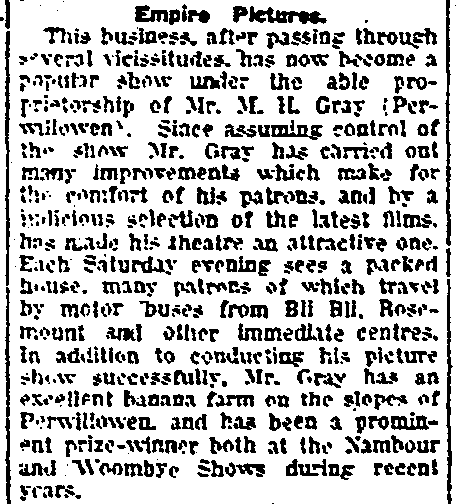
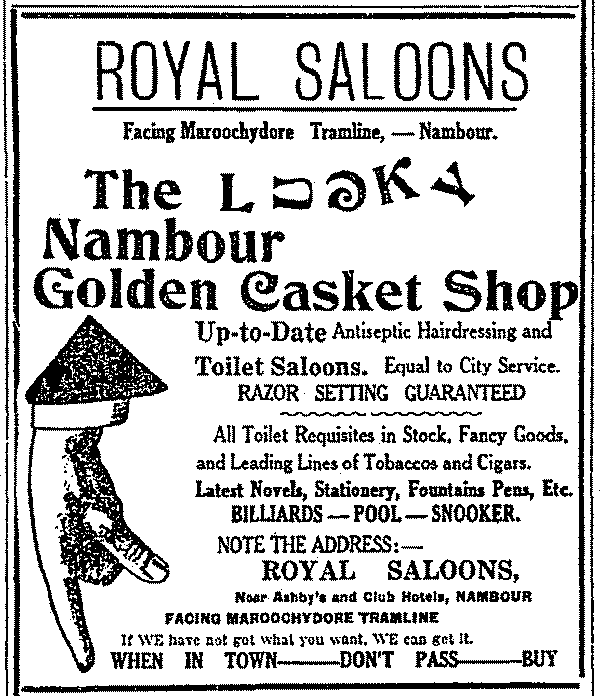
Images courtesy Sunshine Coast Libraries
Regarding Mr Rawlinson, the same Nambour Chronicle of 14th December 1923 stated: "For fifteen months he has been conducting a hairdressing and billiard saloon and fancy goods shop, and in each of the departments he reports that trade has warranted the enterprise. As manager for the Royal Pictures for twelve months, Mr Rawlinson was successful in bringing good houses to the theatre, and has since been considering the opening of an open-air picture palace." {14-12-1923, p.7}

Currie Street in 1923, looking
south from the first floor of the Nambour Town Hall. Mr Rawlinson and his
family lived in the first floor residence above his Royal Saloons shop. It
is the building on the far side of the single-storeyed set of shops to right
of centre, that has three identical gables facing the street.
Photograph courtesy Sunshine Coast Libraries
Three weeks later, Mr Rawlinson's billiards parlour became infamous, for it was under this room that the great fire of 5th January 1924 started, which destroyed much of Nambour's main shopping precinct, reducing seventeen businesses to blackened ruins. Mr Rawlinson lost all of his stock and fittings, but was insured. He received ₤600 for the building, ₤900 for the contents, and ₤175 for the billiards table which was insured separately with Federal Mutual. The problem was that, as well as losing his business, he also lost his home, which was a residence of five rooms, built above the shop, where he lived with his family. After the fire he appears to have ceased business in Nambour, for there are no further references to him in the local newspaper. His plans for an "open-air picture palace" never came to fruition, at least in our town. {11-1-1924, pp.7, 8}
Interestingly, a Mr B. Kirwan came to Nambour with his cine-camera soon after the great fire, and shot a number of reels of film, showing the ruins and also the local banana industry. He edited these into a newsreel-type feature, and wrote to the Empire Theatre, offering it as a program filler along with another of his productions, 'Queensland's Animated Record'. Mr Gray showed the films at the Empire on 19th January 1924, just two weeks after the fire. {18-1-1924, p.9}

Currie Street the day after the
great fire of 5th January 1924.
Photograph courtesy Sunshine Coast Libraries
In September 1924 the Olympic Stadium was opened by Mr Ben Bycroft in Petrie Creek Road, just a few doors down from the Soldiers' Hall. The location was in Howard Street near where Leading Edge Real Estate is today. It was intended to be an all-purpose amusement arena, and initially had a boxing ring installed which was used for some important matches. These were not greatly popular, so Mr Bycroft removed the boxing ring and turned his hall into a skating rink. {19-12-1924, p.5}

The Olympic Stadium was in Howard Street, in the area presently occupied by the Opp Shop and Leading Edge Real Estate.
In 1925 there were two local halls being used as cinemas for screening silent pictures, the Empire Picture Theatre in Howard Street and the Nambour Town Hall. Mr C. W. Gearside was the very successful lessee of the Town Hall cinema. It seems likely that he had installed a second projector during 1924 so that films could be shown without interruption. {19-12-1924, p.5}
The Nambour Chronicle of 19th December 1924 said that there were so many patrons every Saturday night that even standing room was at a premium. During the past year, Mr Gearside had carried out many improvements and often screened films that were yet to be released in Brisbane. Despite his good work, when the Town Hall lease came up for renewal in mid-1925, Mr Gearside was outbid by a Mr Wells, a local businessman.
 Edgar Wells, born in South Africa,
had come to Nambour in 1909 as a
young teenager. He enlisted in the Australian Army on 25th August 1915 at
age 20, when the First World War was bogging down in the trenches of France
and Belgium, and more young fighting men were needed to go 'over there'.
About a week later, another Nambour 20-year-old, Edward Aspland, also
enlisted. Both men wished to serve as motor drivers, and were transported to
Sydney where they embarked on the RMS Osterley on 15th January 1916.
Edgar Wells, born in South Africa,
had come to Nambour in 1909 as a
young teenager. He enlisted in the Australian Army on 25th August 1915 at
age 20, when the First World War was bogging down in the trenches of France
and Belgium, and more young fighting men were needed to go 'over there'.
About a week later, another Nambour 20-year-old, Edward Aspland, also
enlisted. Both men wished to serve as motor drivers, and were transported to
Sydney where they embarked on the RMS Osterley on 15th January 1916.
After a brief sojourn in Cairo during February and March, they sailed from Alexandria to Marseilles in southern France, where they found themselves posted as 'Gunners', Edgar in the 3rd Field Artillery Brigade and Edward in the 21st Field Artillery Brigade. After two months, Edgar was promoted to Bombardier and transferred to the 21st Field Artillery Brigade where he met up with Edward once again. The picture, taken in England, shows Edward standing at left.
During action in Belgium in November 1917, they both came under gas attack, and Edgar saved Edward's life by carrying him to safety. Edward spent some time recovering in the City of London Military Hospital at Clapton before returning to Belgium. Edgar was promoted to Corporal, possibly in consideration of his brave actions. Both men were wounded twice in this way, but served until the armistice before safely returning to Australia in 1919 on different ships, Edward on the Soudan and Edgar on the Orca.
Edgar married Edward's sister, Edith, and operated the Geddes Café in Currie Street that was burned down in the great fire of 5th January 1924. Edgar Wells then bought (or leased) another café from Mr Alf Williams, in a building shared with Williams' Emporium, two doors south of the Commercial Hotel, and ran it for nearly a year, until his brother-in-law Edward approached him in late 1924 with the offer of a partnership in his Returned Soldiers' Garage. {2-6-1922, p.8}
On his return to Nambour, Edward Aspland had set up his Garage with a Mr Bigelow in 1919 and it had flourished, but now Mr Bigelow wished to move on. The Returned Soldiers' Garage was located in Currie Street, a few doors south of the Royal George Hotel. It provided automotive services such as petrol, oil, spares, maintenance and repairs, and was also a dealership for new vehicles, selling Dodge cars and trucks, Overland Whippets and Willys-Knight cars. The block on which the Garage was built was especially suitable, as it was L-shaped, with a side entrance for cars in Bury Street as well as the main frontage in Currie Street. Edgar Wells accepted the partnership with Edward Aspland, and sold his café in January 1925 to Messrs. J. Nichols and S. Baildon, who re-named it the White Rose Café. {11-1-1924, pp.7, 8} {12-12-1924, p.8} {20-12-1929, p.8}
Messrs Wells and Aspland rented the premises of their Returned Soldiers' Garage from a Mr F. W. Walsh of Brisbane. In March 1926 they decided to buy the building from Mr Walsh, and purchased it on 20th March. Ten days later, it burned to the ground in another one of Nambour's disastrous fires. This was the second time Mr Wells had been burnt out in 27 months. Eight other business premises went up that night, including that of Mr F. Bendixen, a general merchant. Like Mr Wells, Mr Bendixen had also lost a previous business in the great fire of 5th January 1924. Wells and Aspland rebuilt the Returned Soldiers' Garage in brick. This was a Government requirement, as Currie Street from Mitchell Street to the Petrie Creek bridge had been proclaimed a 'first class area', and new buildings had to be constructed of fire-proof materials. The Garage operated there until 1960 when the building was taken over by Nambour Agencies. It is now a Bi-Rite Electrical store, and still has entrances in both streets. The driveway across the gutter, giving access to the Garage's workshop, still exists outside the Bi-Rite Electrical store's Bury Street entrance. {1-4-1926, p.9}
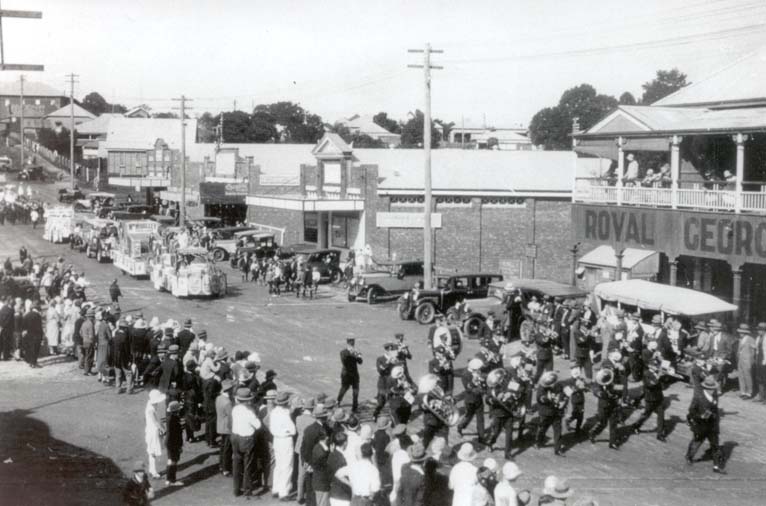
A parade at the southern end of the Currie Street shopping precinct in 1930. Hobson and Beale's brick butcher's shop with large front windows is at centre, with a vacant lot and then the rebuilt Returned Soldiers' Garage to its left. A charabanc (a cross between a large open car and a small bus) is parked outside the Royal George Hotel.
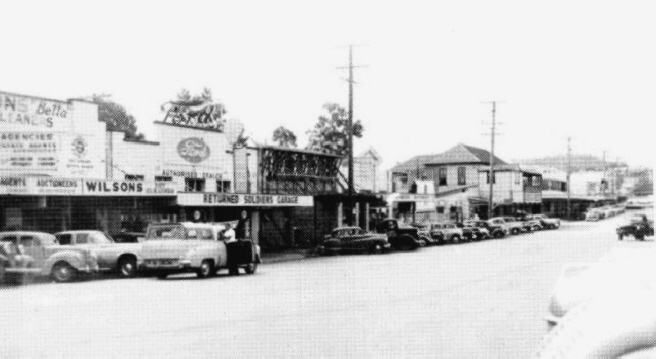
The western side of Currie
Street in about 1958, taken from outside today's Civic Video. The Returned Soldiers' Garage
(now a Ford dealership, second building from left) was on the site occupied by today's Retravision store.
The Royal George Hotel is the two-storeyed building to right of centre. The intersection with
Howard Street is at the right margin.
Photographs
courtesy Sunshine Coast Libraries
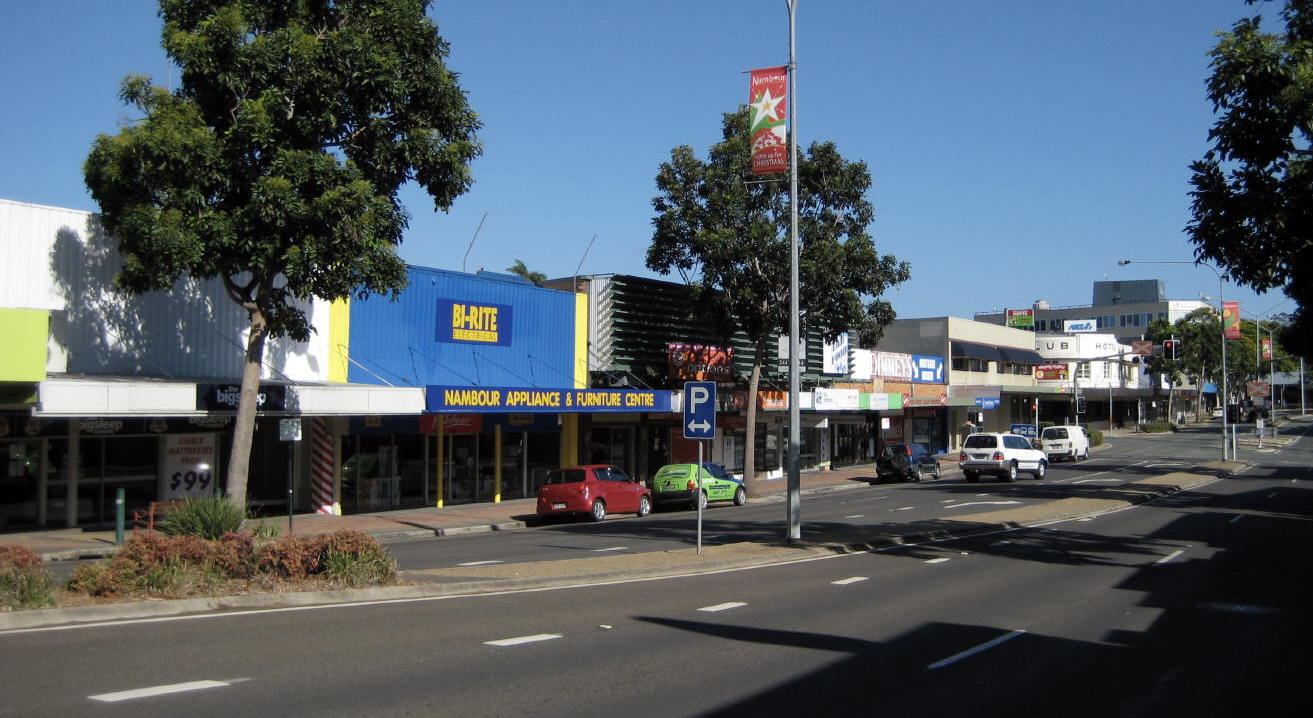
The same view in January, 2013.
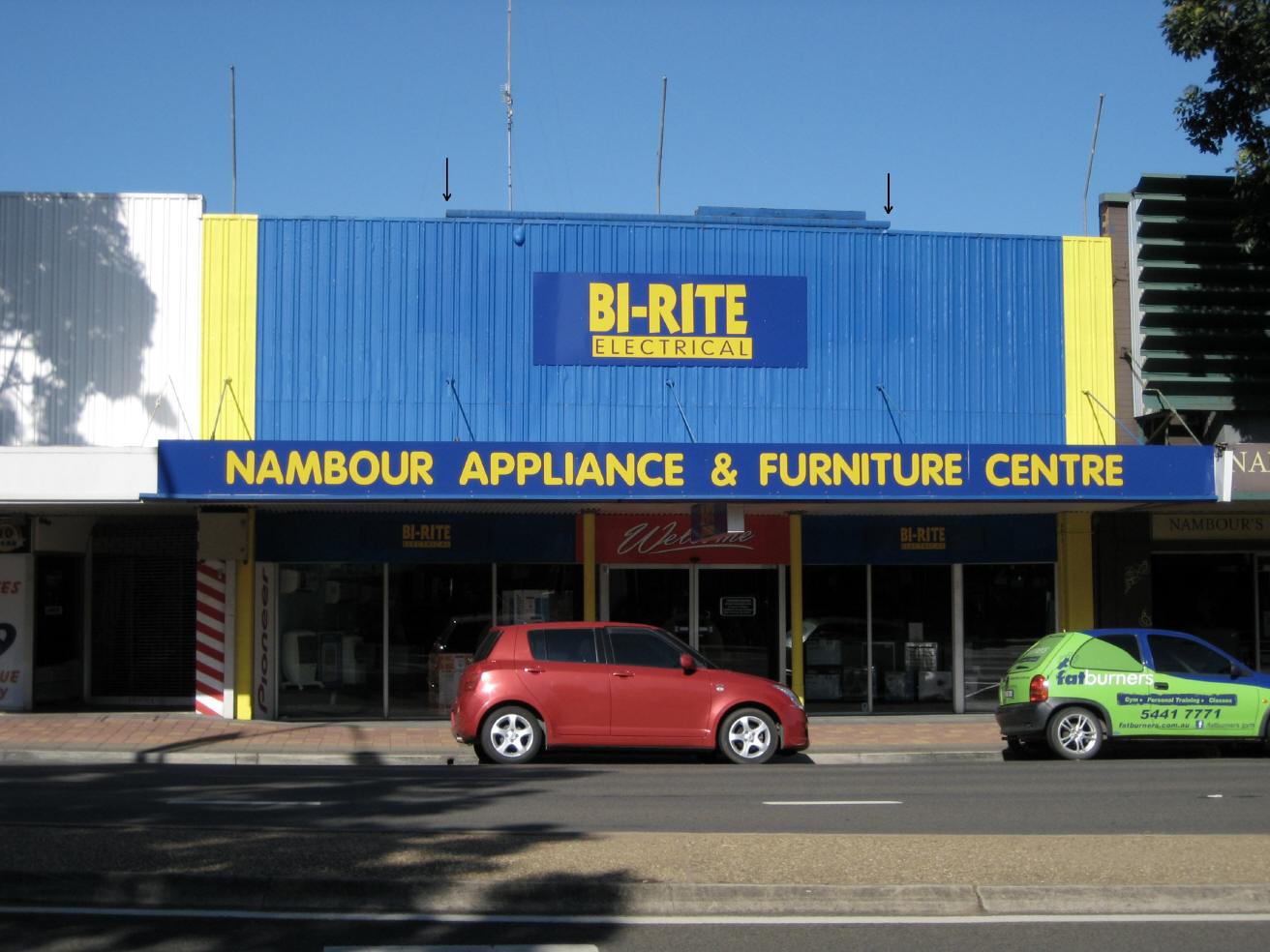
The uppermost course of bricks on the top of the Returned Soldiers' Garage's façade still peeks above the blue and yellow cladding of the Bi-Rite Electrical store's false front.
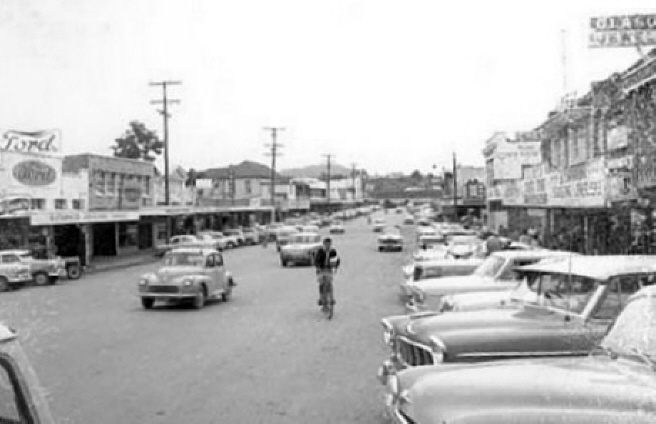
Looking north up Currie Street
from near Bury Street in 1959. The Returned Soldiers' Garage, a Ford
dealership, is the building at extreme left.
Photograph
courtesy Sunshine Coast Libraries
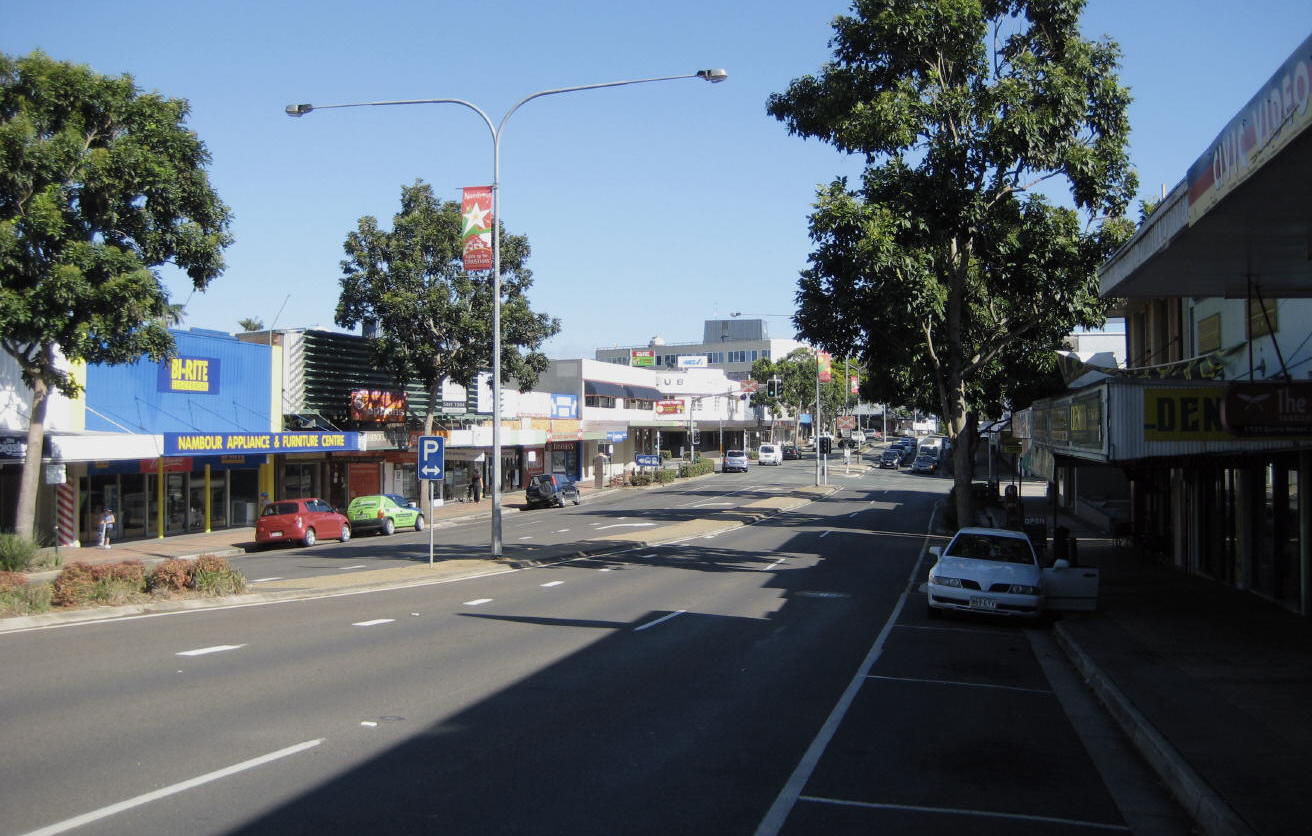
The same view in January, 2013
Mr Wells was a past Vice-President of the R.S.S.I.L.A. and a close colleague of its past President Mr M. H. Gray. He had seen Mr Gray's success with the Empire Pictures, and during 1924 he had taken bookings at his second café for screenings at the Empire. {19-12-1924, p.8} He had developed an interest in the cinema business, so when the Town Hall lease came up for renewal, he sent in a tender and was successful. This meant that the annual licence for showing Town Hall Pictures was transferred from Mr Gearside to Mr Wells, leaving the former unlicensed. Mr Gearside was forced to look for another venue where he could set up his equipment. {19-12-1924, p.5}
Knowing of the nearby Olympic Hall skating rink a few doors down Howard Street from the Empire, Mr Gearside approached Mr Bycroft and leased it one night per week for the showing of motion pictures. He presented his first program on 29th August 1925, advertising the venue as the Olympic Theatre. This immediately aroused the ire of Mr Wells of the Town Hall cinema, who demanded that his landlord, the Maroochy Shire Council, protect his interests.
To investigate the matter, the Maroochy Shire Council held a special meeting within a fortnight, on 8th September, to discuss the separate licensing of halls for picture shows and general entertainment. The four applicants were asked to attend the meeting to present their cases for the granting of licences, and Messrs Gray, Gearside, Bycroft and Wells duly fronted up.
Mr Michael Gray said that he had held a lease on the Diggers' Hall for the past two years, and the lease still had five years to run before it expired. The Hall had been kept well up-to-date, and had been inspected and passed by the Council. He said he would be willing to fall in with any idea or suggestion that the Council could make.
Charles Gearside had his solicitor, Mr W. Daly with him, to present his case. Mr Daly requested a licence to show pictures at the Olympic Hall. He said that his client would withdraw his application for the lease of the Town Hall, and in return asked that no action be taken against Mr Gearside for showing pictures during the previous two weeks without a licence. Mr Daly went on to say that his client was a respectable citizen. He had run the Town Hall pictures for two years, and conducted the entertainments and the Hall in a proper manner. In the face of this, he was a most suitable person to be granted a licence. Mr Gearside now desired a licence to show pictures at the Olympic Hall, which had been passed by the Council for such purposes.
Mr Ben Bycroft, in support of his application for skating, boxing, dancing and vaudeville entertainment at the Olympic Hall, said he was the owner of this Hall, and it had cost him ₤2000 to build it twelve months ago. If the application were not granted then he would be a very heavy loser.
Mr Edgar Wells said that he needed a licence to provide a picture show and general entertainment in the Town Hall. The Hall was up to standard specifications and he hoped that the Council would favourably consider his application and grant him the licence. The four applicants then withdrew from the meeting.
The Council then went into Committee, at which the Press was excluded. When
they emerged, the decisions were:
Licences would be granted to Messrs Wells and Gray for
showing pictures and other entertainment purposes at the Town Hall and the
Diggers' Hall, respectively.
A licence would be granted to Mr Bycroft for the Olympic
Hall, such licence not to include cinematograph exhibition.
As a licence had already been granted for the Olympic Hall,
Mr Gearside's application would be refused. {11-9-1925, p.2}
Mr Gearside did not accept this decision, and continued to screen Olympic Pictures as before.
Mr Wells wrote to the Council saying that there were now two cinemas in Nambour competing against him and he was a heavy loser, not even making his rent. In fact, he was losing ₤5 or ₤6 for every night he was screening. The Council had rules to protect licensed operators such as himself. By showing pictures without a licence, Mr Gearside was acting outside of their by-laws.
Mr Bycroft responded by writing that it was true that Mr Gearside was in breach of the law, but he had "installed the necessary plant at a big expense, and if the Council's decision to prohibit pictures being shown in the Olympic Hall just to protect their own Hall and the lessee, who is a wealthy man, is enforced, it means practical ruination to Mr Gearside and myself. Had the Council informed me that they were not going to allow a licence for pictures in this hall, I certainly would never have built it."
The Council called a special meeting on 6th October to discuss these letters, and resolved that the Olympic Pictures would be closed, forcibly if necessary. Mr Gearside was told that if he persisted, the police would be called, and the hall would be shut down by force. (There were only two policemen in the town at that time.) Mr Gearside ignored this directive, and continued presenting cinema programs for another two months. He made extra money by hiring out his generating plant to provide lighting at night-time social functions. {6-11-1925, p.9} {13-11-1925, pp.1, 8}
The Council would not relent, however, and the Olympic was forced to cease showing pictures after less than four months. In the Nambour Chronicle of 4th December 1925, it advertised a program for the following Saturday night. It was a double bill, The Wizzard of Oz with Larry Simon, the "screen's greatest eccentric comedian" [not the Judy Garland Wizard], and Argentine Love, with Bebe Daniels. A program Head Winds was scheduled for the next Wednesday, and Tom Mix in Dick Turpin on the following Saturday, 12th December. But there was no advertisement for Olympic Pictures in the paper published on Friday, 11th December, or on any subsequent occasion, so we may assume that some time in the first week of December Mr Gearside yielded to Council pressure and presented no more pictures. {4-12-1925, p.8} {11-12-1925, p.8}
The Olympic Hall thus returned to being a skating rink, but introduced some live theatre as well. On 5th February 1926 it was advertising in the Nambour Chronicle a "glorious, glittering pantomime, 'Cinderella', supported by vaudeville items." There was still some anger persisting, for at the bottom of the advertisement there is this notice: "During interval a discussion will take place on Shire Council matters". {5-2-1926, p.8}

Image courtesy Sunshine Coast Libraries
The Olympic Hall continued on until 1927, when it was sold to Messrs Macfarlane and Dunlop, who installed fruit processing machines and turned it into a factory called the Nambour Preserving Company, canning local fruit and making jam. This cannery began operations on 11th August 1927, but was fated to last less than a year.
There were now only two cinemas in the town competing for patrons. Their contending advertisements on the same page of the Nambour Chronicle each week were large and lavishly illustrated. As well as describing the current films being screened, they also whetted patrons' appetites by including information about coming attractions.
Mr Wells at the Town Hall Pictures claimed, "Our lighting, screening and music are superior to any in town. Come and see for yourself." Mr Gray at the Empire countered with "Watch for our free offer of a five guinea phonograph." When Mr Wells screened films twice a week, Mr Gray screened three nights a week and introduced Saturday matinees. It is worth remembering that Mr Wells and Mr Gray were friends, both being returned Diggers and active members and sometime office-bearers of the Nambour Sub-branch of the R.S.S.I.L.A. for many years. One can imagine the friendly rivalry that the two men enjoyed. {5-2-1926, p.8}
During this period, 1926 to mid-1928, Gray and Wells began to work together more and more. An unusual collaboration occurred on 6th November 1926, when the men jointly hired the one program to be shown at both their cinemas on the same Saturday night and at a matinee the same day. It was usual for a program to have some shorts, newsreels, and two main features, which would be shown with a 15-minute interval in between. On this night the main feature was a Cecil B. de Mille epic on 12 reels, called 'The Volga Boatman'. This film was advertised as being the first feature at the Town Hall cinema, starting at 8 pm, while at the Empire it was the second feature, starting at 9:15 pm. The supporting film, 'Tramp, tramp, tramp' with Harry Langdon, began at the Empire at 8 pm, and was the second feature at the Town Hall. It is probable that messenger boys were employed to rush the reels of film the 350 metres between the two cinemas so that each film could be shown at both venues on the one night. {5-11-1926, p.8}
For some reason, the Empire ceased advertising its programs in the Nambour Chronicle for a few months after that. An exception was in the issue of 14th January 1927, when a joint advertisement appeared, headed boldly, 'Town Hall and Empire', and describing a double-bill program. {14-1-1927, p.8} Whether the cinema was closed, or Mr Gray was on vacation or having new equipment installed is not known, but the Nambour Chronicle of 18th March 1927 contained another joint advertisement, headed this time, 'Empire and Town Hall', and describing another double-bill program. {18-3-1927, p.8}


Images courtesy Sunshine Coast Libraries
Quite often after that, Gray and Wells collaborated to screen the same programs at both their cinemas on the same Saturday and Wednesday nights and at the same Saturday matinees. When this happened, the Nambour Chronicle would alternate the names of the cinemas as 'Town Hall and Empire' {14-1-1927, p.8} and next time 'Empire and Town Hall'. {12-8-1927, p.9} The general rule was that, as before, patrons could expect different programs at each cinema. During this period, their advertisements in the Nambour Chronicle were accompanied by large advertisements for programs being screened at Woombye.
In the 1920s, Nambour, a mainly wooden town with no fire brigade nor reticulated water supply, suffered greatly from a number of serious fires, some of which are recounted elsewhere in these pages. In 1928 the 'fire fiend' (as the Nambour Chronicle picturesquely termed it), having already hit Mr Wells twice, now turned its attention to Mr Gray. The Olympic Hall and Gray's Empire Pictures (Diggers' Hall) burned to the ground together on the night of 26th June. As the fire, starting in the boarding house that was built between the two halls, had taken two hours to endanger the galvanised-iron clad Diggers' Hall, Mr Gray, with willing help, had been able to rescue most of his equipment before the roof fell in, including 200 canvas chairs. His generating engine and dynamo had been located in a shed behind the hall, and were undamaged. {21-9-1923, p.9} {21-9-1928, p.5}
He now found himself with projection equipment but no venue. Fortuitously, the lease for the Town Hall cinema came due for renewal two months after the fire. Mr Gray made a successful tender for a five-year lease, outbidding his associate and friend Mr. E. Wells, and moved his equipment into the Town Hall's auditorium. It is possible that Mr Wells was happy to help his Digger mate out by letting him win the lease. Fourteen months later, the Town Hall Pictures went up in flames too, due to a fire caused by one of the movie projectors. Mr Gray therefore lost two Nambour cinemas in 16 months. He was known by all as a true Digger, always smiling despite his reverses. {29-6-1928, p.2} {25-10-1929, p.9}
Within a week of the Town Hall fire, the Nambour Chronicle was reporting that Mr Gray had met with officials from the Shire Council, as he still held his licence to show pictures, and Nambour had lost all its cinemas. They gave him permission to set up an open-air movie venue on rising ground at the rear of Messrs Hobson and Beale's brick butcher's shop in Currie Street. The site backed onto the Moreton Central Sugar Mill, which had nearly finished the year's crush. Mr Gray's friend Edgar Wells' rebuilt Returned Soldiers' Garage was just to the south of Hobson and Beale's. (Interestingly, in later years another cinema, the Vogue, that currently houses Dimmey's bargain store, was built on the self-same block of land.) Gray was required to give assurances that the projection box would be away from any buildings and would be thoroughly protected against fire. Mr Gray soon purchased all the seating accommodation required, and all the machinery, including two replacement projectors. {1-11-1929, p.3} {20-12-29, p.8}
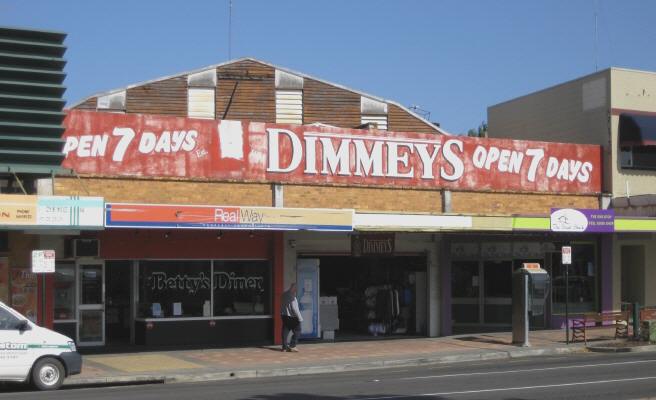
The building that once housed the Vogue Cinema, now used by Dimmeys.
He was ready to present his first open-air program by 2nd November, just ten days after the Town Hall fire. The Nambour Chronicle said that "he had a selection of half-a-dozen very fine features for the program on the Saturday evening. It was not expected that he would have the two projectors running, although these had been purchased. The time at his disposal did not permit of the installation of the two machines. In dealing with the construction of the machines, Mr Gray stated that they were of the latest type, and were now made so that nothing short of a miracle would cause a recurrence of the accident that caused the conflagration of last week." {1-11-29, p.3}


Images courtesy Sunshine Coast Libraries
During that summer of 1929-30, the vagaries of the weather occasionally caused program cancellations. Advertisements were printed in each Friday's Nambour Chronicle, advertising shows for the following night if the weather looked agreeable. If the weather were rainy, no advertisement would appear, and if it were doubtful, the advertisement would state "weather permitting". Despite these problems, Mr Gray was still able to give the first demonstration in Nambour of sound-synchronised pictures (probably music only), which won the general approval of his audience. {20-12-1929, p.8} {10-1-1930, p.8}
 Around
1909, the Maroochy Show Society had built a small
wooden Pavilion at the Nambour Showgrounds. By the early 1920s, the District
Agricultural Show had outgrown it. A new, larger pavilion was constructed in
early 1922, its opening function being held on 21st July of that year. {28-7-1922, p.5}
In 1924, Mr Gray had
screened moving pictures in the Show Pavilion during the Maroochy (Nambour) Show as a
benefit for the Show Society. {8-2-1924, p.10}
In fact, he had given his financial support to have the
larger pavilion built in the first place. As his open-air cinema was being bedevilled
by difficulties with the weather, and the cold nights of winter were approaching, he
asked the Maroochy Show Society if he could hire the Pavilion to present his
programs. They agreed, and he moved his equipment to the Nambour Showgrounds
in June 1930 for four
months. He organised buses leaving
Currie Street every few minutes to
take the patrons out to the Pavilion at a cost of 3d. a head each way. His first program
there was held on 21st June, and was accompanied with "special music by our
electric moviephone." {20-6-1930, p.8}
Around
1909, the Maroochy Show Society had built a small
wooden Pavilion at the Nambour Showgrounds. By the early 1920s, the District
Agricultural Show had outgrown it. A new, larger pavilion was constructed in
early 1922, its opening function being held on 21st July of that year. {28-7-1922, p.5}
In 1924, Mr Gray had
screened moving pictures in the Show Pavilion during the Maroochy (Nambour) Show as a
benefit for the Show Society. {8-2-1924, p.10}
In fact, he had given his financial support to have the
larger pavilion built in the first place. As his open-air cinema was being bedevilled
by difficulties with the weather, and the cold nights of winter were approaching, he
asked the Maroochy Show Society if he could hire the Pavilion to present his
programs. They agreed, and he moved his equipment to the Nambour Showgrounds
in June 1930 for four
months. He organised buses leaving
Currie Street every few minutes to
take the patrons out to the Pavilion at a cost of 3d. a head each way. His first program
there was held on 21st June, and was accompanied with "special music by our
electric moviephone." {20-6-1930, p.8}
Mr Gray saw that the new Maroochy Shire Hall was being built with a much larger auditorium for showing pictures, and was told that the cost of the lease on the new hall would be much dearer than that which he had paid in the old Town Hall. {24-1-1930, p.8} {20-6-30, p.8}
He contacted his Digger friend and picture-showing competitor Edgar Wells, and together they agreed to form a partnership, and to apply for a joint lease on the new Maroochy Shire Hall. At its May 1930 meeting, the Shire Council was told that about ₤240 per year (₤20 per month) could reasonably be earned from the Hall hire. Messrs Gray and Wells were present at that meeting, as part of a deputation from the R.S.S.I.L.A. to have a soldiers' clubroom built in the projected new Maroochy Shire Hall to replace the Diggers' Hall that had been totally destroyed by fire in June 1928. The Council rejected that proposal, so the R.S.S.I.L.A. decided to raise funds to rebuild their Diggers' Hall instead.
Mr Gray felt that the hiring charges of the new Shire Hall would be too high for Mr Wells and him to manage. He had leased the previous Diggers' Hall as the Empire Pictures, and he and Mr Wells, as returned Diggers and active R.S.S.I.L.A. members, were both anxious to see their lost Hall replaced. They therefore decided to forget the incomplete Shire Hall and to work towards having the Diggers' Hall rebuilt. The new Digger's Hall cost ₤3000 to build, and the Nambour Sub-branch of the R.S.S.I.L.A. had to take out a substantial loan to pay for it. Mr W. Lanham was the builder. By October 1930 the Hall was completed, and Mr Gray moved his equipment out of the Show Pavilion and back into town. He installed it in the new Diggers' Hall on the same site as the old one, and advertised the first screening there on 25th October, the day after the Hall's official opening. He was able to do this as the licence to show moving pictures on the site had covered the old Diggers' Hall that had been burned down, and now covered the new building. {14-5-1943, p.5} {17-10-1930, p.8}
Mr Gray's advertisement stated: "A modern and up-to-date plant is being installed, and will consist of Two High-Class Projection Machines, and One Imperia (British) Transrector, the first of its kind installed in Queensland. This combination will give continuous non-stop projection equal to the best anywhere. We intend screening pictures every Wednesday and Saturday nights. For Hall bookings, see Mr Gray, or ring 'Phone 30." It would appear that a 'transrector' was an automatic electric device that would switch the projected image instantaneously from one projector to the other at the ends of reels, so that the audience was unaware of any pause in the movie. {24-10-30, p.8}
For some reason Mr Gray ran an identical advertisement the following week, so there may have been initial problems. The venue for the new cinema was simply given as the 'Diggers' Hall', and the pictures shown were still silent. Meanwhile, the new Maroochy Shire Hall was under construction and due for completion six months later. {17-10-1930, p.8} {24-10-1930, p.8} {31-10-1930, p.8} {10-4-1931, p.8}
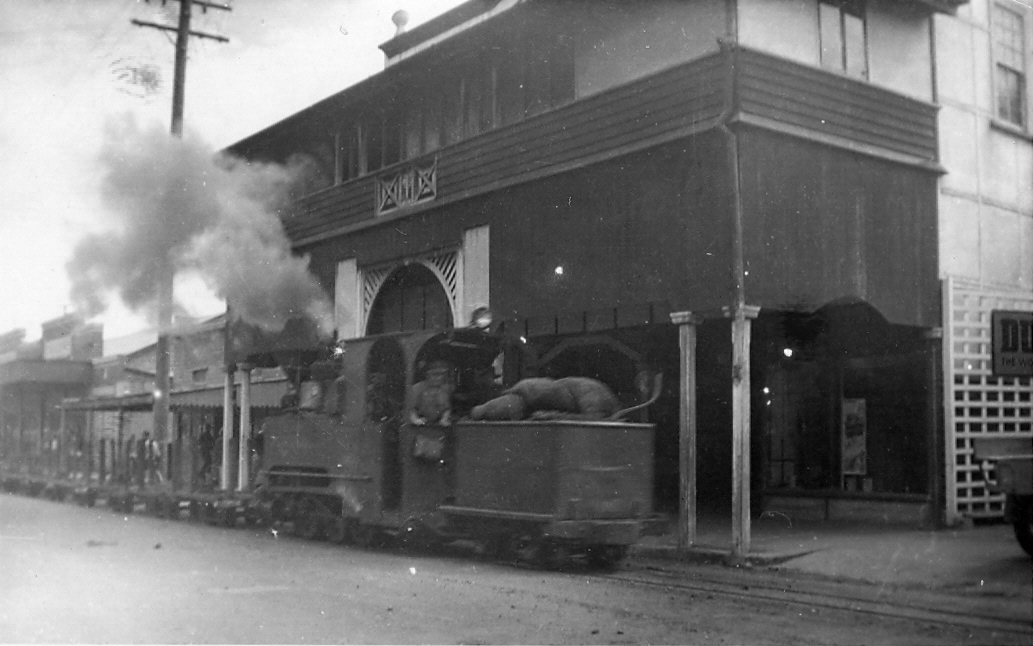
Moreton taking empty cane trucks down Howard Street, Nambour, past the replacement Diggers' Hall.
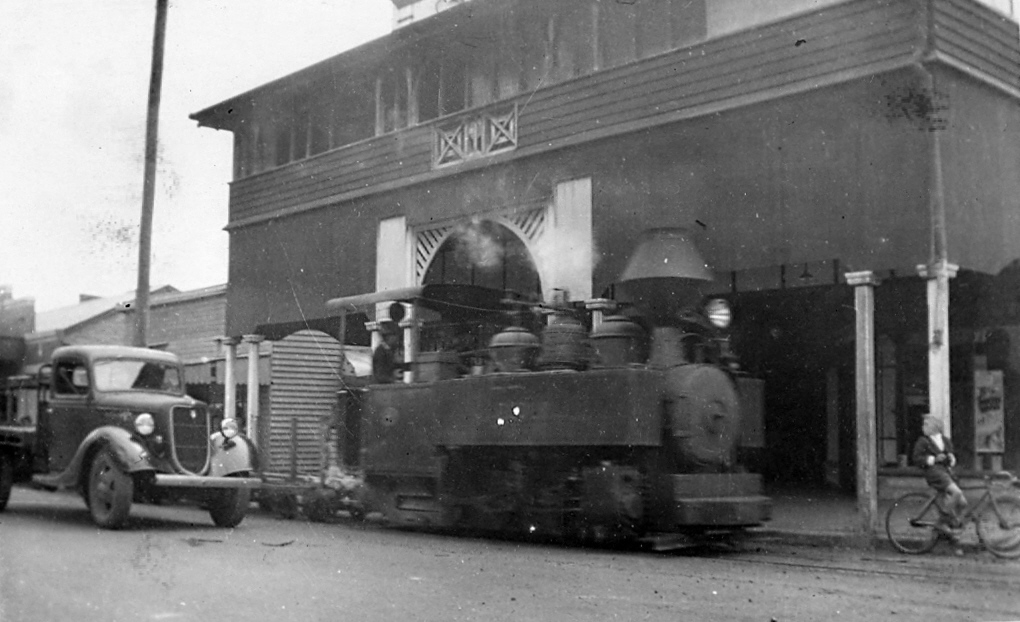
Coolum passes the second Diggers' Hall on the Queen Street corner as it takes empties down Howard Street

The new Diggers' Hall was the venue for celebrations when the Nambour Rural
School moved its location from Mitchell Street (adjoining the Sugar Mill) to
a more spacious site in Carroll Street.
Image courtesy Sunshine Coast Libraries
By March 1931, the new Shire Hall was completed at a cost of exactly ₤13,645-12-6d, and the official inauguration was approaching. The Council hoped that the Hall's cinema would also be ready for the opening, and at a Council meeting on 24th March, they called for expressions of interest from movie exhibitors, stipulating that the cinema be equipped for sound pictures, or 'talkies'. Mr Gray and Mr Wells attended this meeting to look over the auditorium, and were very impressed with its size and quality. As it could accommodate a much larger audience than the Diggers' Hall, it would be a much more profitable venue. They decided that they could manage the ₤20 per month lease, and offered to sign up then and there. They were disagreeably surprised to be told that in the intervening ten months since the last meeting they had attended, the hiring charge had leapt to ₤30 per month, but if the lease were for ten years then the Council would accept ₤27 per month. Not expecting such a large increase, Gray and Wells offered a maximum of ₤25 per month, but the Council would not accept that. After withdrawing for a few moments to confer, Gray and Wells agreed to the Council's terms, and a ten year lease was signed and came into effect on 7th April. {16-5-1930, p.6} {14-5-1943, p.5}
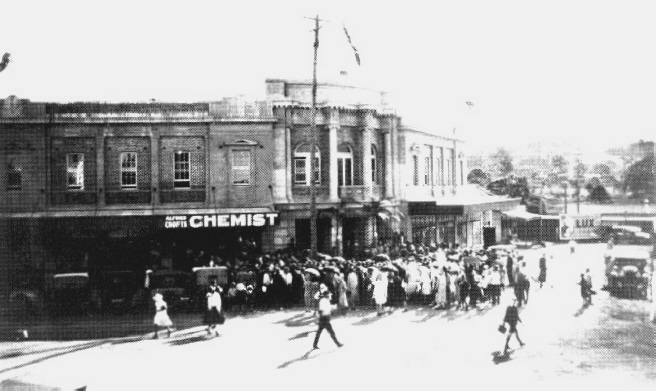
The opening of the new Maroochy Shire Hall on 7th April, 1931. Mr Crofts has leased a Chemist shop on the same spot as he had occupied for 16 years in the old Town Hall, and indeed for 13 years before that Hall was built, in a small wooden shop. He had been occupying the site since about 1900.
The Maroochy Shire Hall in 1932. The arched roof of the cinema attached to the rear of the building can be seen to the right of the main façade. Station Square is the small park at right.

The four-year-old Maroochy Shire Hall in 1935.
Photographs courtesy Sunshine Coast Libraries
Messrs Gray and Wells knew that there would be considerable expense involved in purchasing new projectors equipped with the latest optical sound equipment, together with amplifiers, loudspeakers, and sufficient canvas chairs to fill the auditorium. They therefore decided to take in some partners. Moving swiftly, they contacted three friends and within a few days had set up a new company, Nambour Pictures Limited. This company was registered at the Supreme Court in Brisbane on 15th April 1931. The seven subscribers were listed as: Michael H. Gray (picture exhibitor), Vera G. Gray (housewife), Edgar Wells (garage proprietor), Edith Wells (housewife), Stephen J. Hobson (Tramway Manager), Eric B. Fox (solicitor), and Hope C. B. Murray (public accountant), all residents of Nambour. The registered office was at Wells' Returned Soldiers' Garage in Currie Street. Over the years leading up to the Town Hall fire, Messrs Gray and Wells had become friendly with Stephen Hobson, as his office was located in the Town Hall where they had screened their pictures. He was a Shire Council official whose responsibility was to manage the Mapleton and Buderim Tramways. {1-4-1926, p.9} {20-12-1929, p.8} {1-5-1931, p.8}
By pooling their resources, the partners were able to purchase and install new state-of-the-art Western Electric projection and sound equipment. The Nambour Chronicle of 10th April 1931 ran the final advertisement for moving pictures in the Diggers' Hall ('Metropolis' and 'Sparkling Youth'), and alongside it a second advertisement for the Talkie Opening at the new Maroochy Shire Hall (still described as the 'Town Hall'). Nambour Pictures Limited presented the town's first 'talkie' film, 'Rio Rita' in the new Shire Hall on 18th April 1931. {10-4-1931, p.8} {17-4-1931, p.8} {24-4-1931, p.6}

Image courtesy Sunshine Coast Libraries
Gray and Wells continued to screen silent pictures at the Diggers' Hall, but the service was substantially reduced. This made it available for other functions, and on 14th April 1931 the building was the venue for a J. C. Williamson Ltd production of 'Journey's End'. The advertisement in the Nambour Chronicle was careful to stipulate that the production was "THE PLAY - NOT THE PICTURE" (above). {10-4-1931, p.8}
During the 1930s the movie programs continued to decline in number and the Diggers' Hall became a popular venue for live entertainment and dancing. As such, it continued to be well-patronised until the outbreak of World War II.
Nambour Pictures Limited operated the Town Hall Talkies in the Maroochy Shire Hall (renamed the Nambour Talkies) successfully through the 1930s, but by 1939 the ten year lease was approaching its expiry date, November 1941. Gray and Wells at the Nambour Talkies were not concerned, as they fully expected that renewal and re-negotiation of the lease would be only a formality. They thought that they would continue to operate through the 1940s as they had done in the previous decade. Little did they know that they would be well and truly out-manoeuvred and out-politicked by people who were determined to wrest their cinema away from them. The story continues here.
Digital Nambour Chronicle Picture Sunshine Coast